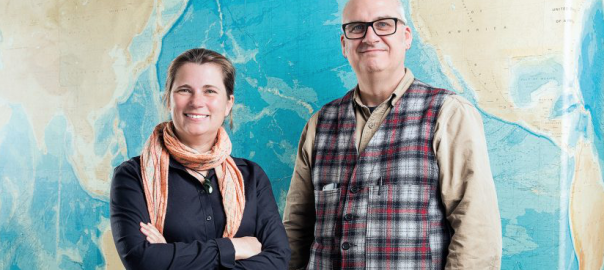Modeling the diverse world of phytoplankton opens up a predictive view of our own. MIT’s Spectrum Magazine spotlight’s the Darwin Project.
Read this story at MIT Spectrum
It’s taken a few hundred thousand lines of code and the better part of a decade for Mick Follows, Stephanie Dutkiewicz, and their colleagues to conjure up an approximation of the global ocean inside their computers. These two MIT oceanographers are on a mission—called the Darwin Project—to know everything they can about phytoplankton, the tiny plants of the sea that produce half the oxygen that we breathe, underpin oceanic food webs, and are key players in the flow of carbon on our planet. (In fact, phytoplankton lock up a tremendous amount of carbon in the ocean that would otherwise be floating in the atmosphere.) To achieve their goal, Follows (associate professor in the Department of Earth, Atmospheric and Planetary Sciences) and Dutkiewicz (principal research scientist at MIT’s Center for Global Change Science) want answers to questions about the growth and death of these micro plants, what characterizes the environments where they’re found, and how different types of phytoplankton interact with one another.
“If we can describe this complicated system with mathematics with some predictive power,” says Follows, “then we know we’re understanding something essential about how that system works.”
By their own admission, Follows is the dreamer and Dutkiewicz is the pragmatist. For instance, when considering how many types of phytoplankton to include in their model, Follows suggested hundreds. Dutkiewicz countered with six. They’ve settled on 51, and the sizes of those types span nine orders of magnitude—equivalent to the difference in scale between a mouse and Manhattan.
All these kinds of phytoplankton aren’t just ingredients in the Darwin Project’s hard drives. Dutkiewicz says, “Trying to understand the how and why of diversity is at the heart of everything we do.”
When they compare what the model predicts to actual data gathered by ships, satellites, and lab experiments, it checks out. “It’s confirmation of our understanding reduced into a set of equations,” says Follows. The model captures the behavior of both the phytoplankton and the ocean they inhabit. This means it can be used to project what might happen in the future—during an El Niño year, say, or 100 years from now as our global climate continues to change.
“Phytoplankton produce half the oxygen that we breathe, underpin oceanic food webs, and are key players in the flow of carbon on our planet.”
Leading a team of a dozen MIT researchers, plus a handful of collaborators from universities around the world, Follows and Dutkiewicz have used their digital ocean to understand all sorts of things. Their investigations range from the geographic distribution of biodiversity in general and the various types of phytoplankton in particular, to where and how fast nitrogen gas is being incorporated into certain kinds of phytoplankton (a process that helps sustain entire food webs); and from how phytoplankton that occupy such a vast range of sizes can coexist, to how the physical movement of water on the planet influences the biology it contains.
The computer simulations of the Darwin Project have produced stunning visuals: some, for example, depict the Earth with darkened continents surrounded by an ocean swirling with color and churning with movement and life. According to Dutkiewicz, the visualizations have been “incredible outreach tools,” allowing both scientists and nonscientists to see the ocean in a new way. They’ve been featured in displays at the San Francisco Exploratorium and the planetarium at the Museum of Science and Industry in Paris. “They’re really beautiful to watch,” Dutkiewicz says. “You get a sense of how dynamic the ocean is and how dynamic the phytoplankton communities are.”
As the Darwin Project evolves, it grows increasingly complex. Follows, Dutkiewicz, and their colleagues have started incorporating into the code representations of ocean bacteria, seafaring viruses, and yet more diversity of phytoplankton and the organisms that eat them. By continuing to refine and improve their simulations, they seek to deepen our understanding of marine ecosystems. And if one day these equations are capable of tracing out the living contours of the ocean, we’ll have a powerful tool for understanding our future—both at sea and on land.
Image credit: Ken Richardson, courtesy MIT Spectrum Magazine.
